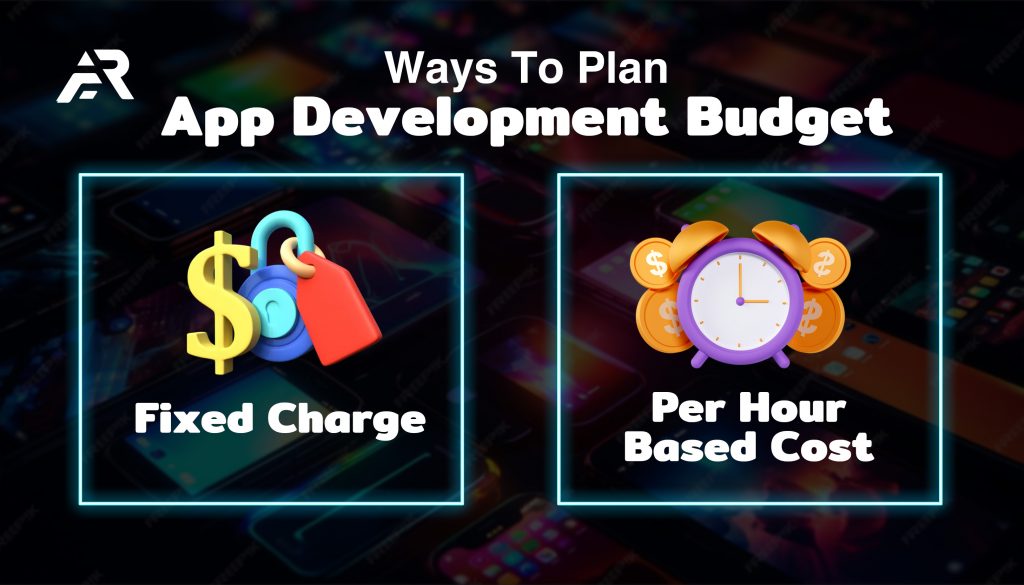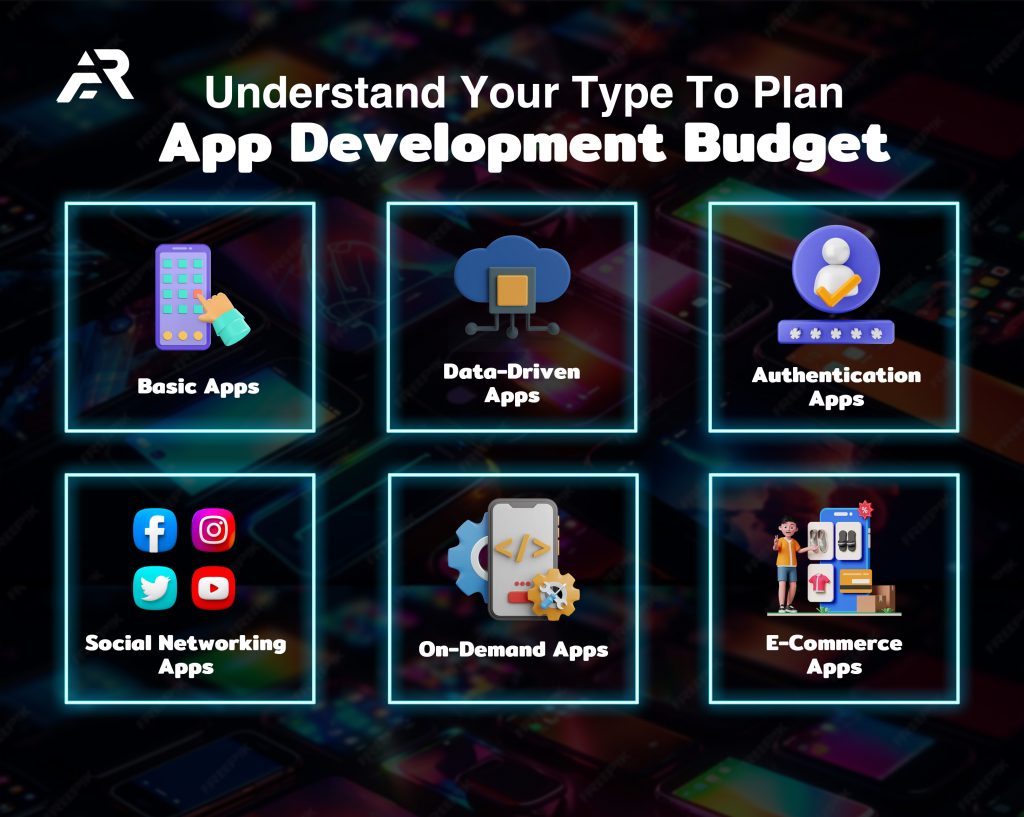Picture this, you’re planning to create a mobile app for your business, then you need an app development budget to get a roadmap of the whole process. It helps you figure out what will be essential for your application to shine.
Around the globe, there will be 6.92 billion smartphone users in 2023. That means 85.74% of the global population owns a smartphone. (Source: Bank My Cell)
In 2022, the global mobile app market was worth about $206.85 billion, and it is expected to grow at a rate of 13.8% each year from 2023 to 2030. (Source: Grand View Research)
Nowadays, everyone is glued to their mobile phones and using multiple apps. However, in this situation, you should plan to develop a mobile application. It will help you reach your target audience easily.
Developing a mobile app is not just a fancy addition; it is a basic need. It will help you attract more customers than usual; people will recognize your brand and give you loyal customers.
This article is like your guidebook for the whole planner for your app development budget. It helps you understand the costs, plan your steps, and ensure your new app is born without burning a hole in your pocket.
So, get ready to bring your app dreams to life and keep it wallet-friendly.
Shape A Plan With Your App Development Budget

- Cracking the Code
Before diving into the budgeting process, it’s essential to understand the elements that influence your mobile app development costs.
- Platform Choice
Choosing between Native or Hybrid can be a pivotal decision. Each platform comes with its challenges and nuances, impacting development time and costs. The choice often refers to your target audience and the features you want to incorporate.
- Design and User Experience
An eye-catching design and a seamless user experience are non-negotiable. Investing in skilled designers and UX experts might seem like an additional cost, but it’s a crucial factor in determining your app’s success.
- Integration of Advanced Features
Basic features are to be included in your plan for the app development budget. However, integrating some advanced features will influence the mobile app development cost. Careful consideration of the value they bring to your app versus the cost is paramount.
All the elements affect the budget you have planned for your mobile app development. You need to think about what elements you want in your mobile app. First, you must consider what kind of app you want to develop.
Ways To Plan App Development Budget

- Fixed Charge
Imagine ordering a Subway sandwich with fixed toppings. If you know exactly what you want, a fixed charge is your go-to. It’s great for small projects where everything is crystal clear. You agree on a set cost, and that’s what you pay.
- Per Hour Based Cost
Now, think of this as paying by the hour, like hiring a handyman. This is the go-to for more complex projects where things might evolve. The cost of mobile app development depends on the time and effort invested.
App Development Cost = Hourly Rate x Total Development Time
Understand Your Type To Plan App Development Budget

There are multiple kinds of mobile apps. And every mobile app development cost differs from each other.
- Basic Apps
Think of a basic app like the calculator on your phone, which is straightforward and does its thing without needing the internet. These are apps with about five to six screens.
Examples include your clock, camera, or local audio/video players.
Budget: $5,000 to $15,000
- Data-Driven Apps
These apps need the internet to work, but only for specific information. No fancy logins here. Think of your weather app; it uses outside data to tell you if you need an umbrella.
Budget: $7,000 to $ 15,000
- Authentication Apps
Now, these apps want you to log in. They have user accounts and a bit more complexity. Google Drive is a good example. Facebook and Twitter social logins make the process easier.
Budget: $10,000 to $60,000
- Social Networking Apps
The big players like Facebook or Instagram fall here. They let you chat, share photos, videos, and more. They start small, like Instagram with just square photos, and then you can zoom in too.
Budget: $10,000 to $300,000
- On-Demand Apps
These apps cater to specific needs. Uber or Zomato is a prime example; it connects you with your respective needs. They require logins and often include chat features.
Budget: $50,000 to $100,000
- E-Commerce Apps
Apps like Amazon or Meesho fall into this category. They need logins and have loads of products, wish lists, and a cart for your purchases. They also need a backend team to handle payments and inventory.
Budget: $50,000 to $300,000
| Types | Cost (Approx.) |
| Basic Apps | $5,000 – $15,000 |
| Data-Driven Apps | $7,000 – $15,000 |
| Authentication Apps | $10,000 – $60,000 |
| Social Networking Apps | $10,000 – $300,000 |
| On-Demand Apps | $50,000 – $100,000 |
| E-commerce Apps | $50,000 – $300,000 |
Steps to Plan Your App Development Budget

Now that the groundwork has been laid, let’s take a look at the roadmap for the step-by-step process of planning your mobile app development budget.
Step 1: Define Your Objectives
Before even thinking about numbers, define your objectives clearly. The purpose of your app or the target audience will be your top priority. These questions lay the foundation for the cost of mobile app development.
Step 2: Conduct Market Research
Market research is your compass in the vast sea of mobile app development. Understand your competitors, identify market trends, and analyze user expectations. This information is invaluable in shaping your app features, and consequently, you need to plan an app development budget.
Step 3: Choose Your Tech Stack
The backbone of any mobile app is the tech stack required. Mobile app development companies decide what combination of programming languages, frameworks, and tools to use. This decision significantly influences development time and costs.
Step 4: Development Phase
Divide your app development into distinct phases. From design and development to testing and deployment, breaking down the process allows for a more granular budgeting approach. Each phase comes with its own set of costs and challenges.
Step 5: Factor In Contingencies
The tech world is dynamic, and surprises are inevitable. Factor in a contingency buffer in your budget to accommodate unexpected changes, updates, or pivots in your development journey.
Step 6: Iterate And Refine
Budgeting is not a one-time task; it’s a dynamic process. As your app progresses, continuously iterate and refine your budget based on real-time insights and feedback. This adaptability ensures that your budget remains aligned with your evolving development needs.
How To Reduce App Development Cost

Developing your mobile application can be a bit expensive. Reducing the budget for app development is crucial. Consider all the factors for your business when looking to create a successful mobile application.
Every business wants to develop a high-quality app, you just need to find ways to optimize the process and a mobile app development budget template.
Define Clear Objective
Before starting any journey, it is important to have a clear objective for your project. Just stick to the basics; you should not go for those features that will just hang at the side. Understanding the core functionality of the whole process will help you cut the budget for developing an app.
Choose The Right Development Approach
Selecting an appropriate approach can help your mobile app development budget. There are different kinds of development approaches, and they have their expenses.
As with native app development, it tends to be more expensive than cross-platform or hybrid app development. Cross-platform frameworks like React Native or Flutter allow developers to write code once and deploy it across multiple platforms.
Open Source Technologies
There is another factor that can help you reduce the budget for app development, and that is using open-source technologies. For some basic features, multiple robust open sources and libraries are on the market. They eliminate the need to build certain features from scratch. This will not only speed up the development process but also reduce the cost of creating an app.
Outsourcing App Development
Outsourcing app development to other countries can significantly reduce the mobile app development budget. However, it can be a difficult task to select the right fit for your project.
There are multiple kinds of services that all these mobile app development companies offer. You just need to have clear communication regarding it, which can speed up the whole process.
Optimize Design and User Interface
Streamlining the user interface can contribute reduction in the cost of designing mobile apps. A simple and intuitive design not only enhances the user experience but also rescues development efforts. Minimizing complex design elements and unnecessary features helps in focusing on core functionalities. The better the design, the better the customer experience.
Cloud Services
A huge amount of storage can be a huge help for the mobile app development budget. And for that leveraging cloud services for hosting, storage, and other infrastructure, eliminates the need for substantial upfront investments in hardware.
These cloud services are scalable, allowing businesses to pay only for the resources they use, which is a more effective approach for your budget for developing an app.
Continuous Monitoring
The most important point that helps reduce the mobile app development budget is to have continuous monitoring of the application. Regular feedback and analytics can enhance efficiency, and user satisfaction and ultimately contribute to cost savings in the long run.
Reducing app development costs involves a combination of strategies. By carefully considering each aspect of the development process and implementing these cost-efficient strategies, businesses can create high-quality mobile applications that meet user needs without exceeding budget constraints.
Importance Of App Development Budget
A well-defined budget is not just a financial roadmap. It’s a strategic compass that guides your app development journey.
Risk Mitigation
Budgeting serves as a safeguard against unforeseen challenges. Whether it’s a sudden change in technology or a shift in market trends. A robust plan for an app development budget helps you navigate through uncertainties.
Realistic Goals
Setting realistic goals is the cornerstone of any successful venture. A well-planned budget ensures that your expectations align with your financial capabilities. It prevents overreaching and subsequent disappointment.
Resource Allocation
Budgeting allows you to allocate resources judiciously. From human capital to technological investments. A clear budget ensures that every penny is directed towards maximizing efficiency and achieving your app development goals.
Conclusion
It concludes that you need to plan an app development budget anywhere from $5,000 to $300,000, or it can be even more. However, there is a twist you cannot just assume the cost of mobile app development.
Mobile app development is a whole process. You need to see what factors should be there in your mobile app, and from that the mobile app development budget can be determined.
App development companies can be your ideal choice for a better planner. They take your app dreams and turn them into reality while figuring out the cost puzzle for you. It’s like having a guide who knows the secret sauce for your app’s success.
FAQs
Q1. What is the cost of developing an app?
Based on the recent market demands, the cost to create an app can start from $5,000 and go to $200,000 and even more. The exact cost of an app cannot be assumed, but it all depends upon the mobile app requirements.
Q2. How do you create your budget for an app?
There are a few steps that can help to create your mobile app development budget.
Step 1: Define your objectives
Step 2: Conduct market research
Step 3: Choose your tech stack
Step 4: Development Phase
Step 5: Factor in contingencies
Step 6: Iterate and Refine
Q3. How much does it cost to maintain an app?
The cost of maintaining the application varies depending on multiple factors. Those factors mostly include bugs fix and updates. One more factor that adds up to the cost is the support requirement.
Q4. Difference between fixed charge and per-hour-based cost in mobile app development?
Selecting a price model for your app development budget depends on the requirements.
- The fixed charge model is for those who have fixed requirements and scope for the entire project.
- The hourly-based price model is for those who are not sure about the whole planner for their mobile app. With time they can have the changes and maintenance at the same time.
Q5. Are there any ongoing costs after developing the app?
Development of the application is just the initial phase of your project. Once the application is launched, it needs testing, bug fixes, and updates. These factors can not be eliminated but they can be optimized based on the requirements one will share with the app development company.

0 Comments